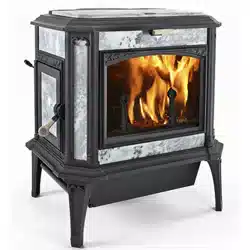Loading ...
Loading ...
Loading ...

8. Adjust the air control damper to a lower setting by lifting the lever up.
The lower the burn rate, as less air is entering the firebox. The final
damper setting will be determined by the desired heat output from the
stove, the condition of the wood being burned, and the draft through the
chimney system.
Engaging the Catalytic Combustor
The catalytic combustor will start to burn the gases and particles in the
smoke when the temperature of the smoke reaches approximately 500ºF,
or after about 10-15 minutes of establishing a strong fire. Each stove
comes with a surface thermometer and a probe thermometer. Use the
surface thermometer to monitor stove surface temperatures. The temperature on top of the stove is
approximately 1/2 the temperature inside the stove, so when the thermometer on the stove top reads
250ºF, it is 500ºF inside. You will find that after the combustor is engaged, surface temperatures will
often rise considerably- evidence that the combustor is producing lots of heat! The probe thermometer
reads the temperature just one inch downstream from the exit face of the catalyst.
Engage the combustor by turning the bypass handle (front of the stove) counter clockwise until it clicks
into its position. Then reduce the air damper to achieve the desired burn rate. Make fine adjustments
to your air control damper by moving it slightly up or down. You may find that you can achieve the
longest burn when the damper is only slightly open. In the Progress Hybrid, allowance is made for a
small amount of primary and secondary air to enter the stove even when the damper is fully closed, and
the stainless steel catalyst will work efficiently at low to moderate firing rates, thus preventing creosote
formation or excessive smoke from your chimney.
Low & Overnight Burning
These instructions are intended as a guide to operating your wood stove. Your timing and final damper
settings will vary depending on chimney draft, type of wood, moisture content of the wood and size of
the splits. The Progress Hybrid is simply designed and intended to be user friendly, but it will take some
practice to get used to it.
1. Before you open the loading door, you must fully open the catalytic bypass and the air damper. Wait
a minute or so for a strong draft to be established to prevent smoke from spilling back into the room.
2. Stir up the hot coals. If necessary, excess ash should be removed before reloading the firebox. If your
stove has the optional ash pan, simply rake the hot coals back and forth in the firebox to allow the loose
ash to fall through the grate into the ash pan. If your stove does not have an ash pan, push the hot coals
to one side and shovel the loose ash into a non-combustible ash container with a tight fitting lid. Dispose
of the ash properly.
Never put an ash container on a combustible surface, like a wood floor.
3. Place several small splits on top of the hot coals and allow them to ignite.
4. Load the firebox to capacity leaving space for secondary combustion, with a mix of larger and
smaller splits. Close the loading door.
5. Adjust the air damper to its the low burn setting by raising the lever up to
reduce the air flow, generally around the last big notch.(fig 3).
6. Close the catalytic bypass, by turning the handle counter-clockwise until it
stops.
7. Initially the fire may appear to die out. This may cause a small amount of
soot to collect on the glass. Any buildup on the glass should go away with
higher t emperature burns.
Never burn the stove with the air damper fully open except when kindling a fire or reloading the
firebox.
16
CAUTION
NEVER USE GASOLINE,
GASOLINE TYPE LANTERN
FUEL, KEROSENE, CHAR-
COAL LIGHTER FLUID OR
SIMILAR LIQUIDS TO
START OR “FRESHEN UP” A
FIRE IN THIS STOVE. KEEP
ALL SUCH LIQUIDS WELL
AWAY FROM THE STOVE
WHILE IT IS IN USE.
Lower Air Damper Setting (fig 3)
Loading ...
Loading ...
Loading ...
